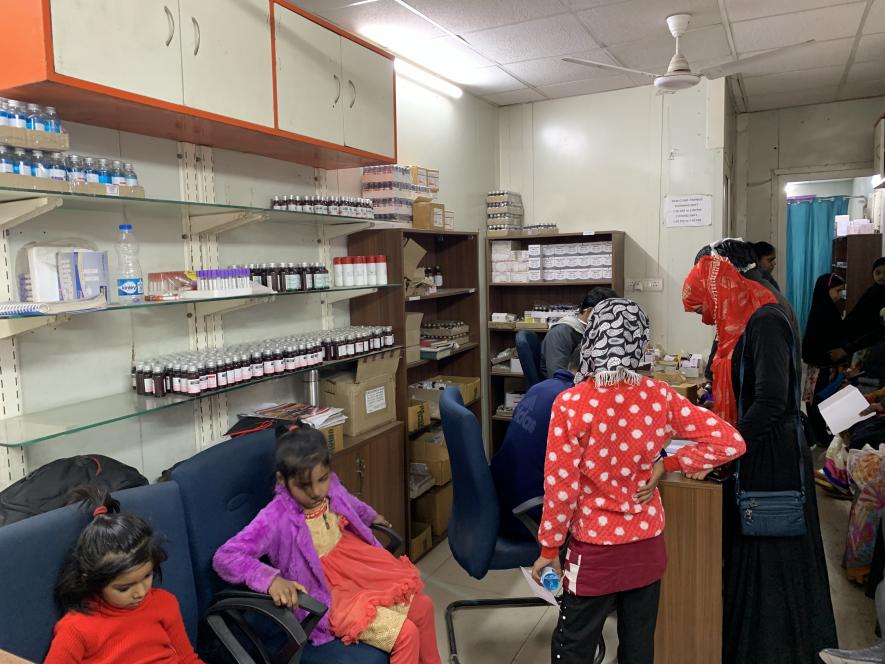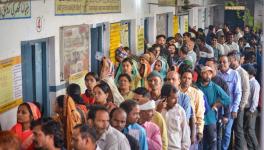Delhi Elections: Will Health Initiatives Bring Victory for AAP?

AAP's Mohalla Clinic near Andheria Mod. Image credit: Ravi Kaushal
It’s a crammed cabin with almost 20 patients divided between two rooms awaiting their turn to see the doctor. While the doctor carefully listens to the symptoms narrated by the patients, two assistants in the first room maintain a diary of patients and a record of medicines distributed. This is, more or less, a common sight at any Aam Aadmi Mohalla Clinic across the national capital, but NewsClick visited the one located near the Andheria Mod in a middle-class neighbourhood of South Delhi.
The clinic, like other 301-odd primary health centres, has emerged as a crucial stop for the urban poor seeking medical advice. The clinics are also playing an important role in Aam Aadmi Party’s campaign in poll-bound Delhi, where citizens will vote on February 8 to elect the new government. The party is locking horns with the Bharatiya Janata Party—in power at the Centre—which is largely seen to be banking on its communal agenda.
Salma, holding her slip, comes out of the cabin along with her daughters. Soon, she is handed two bottles of cough syrup, a strip of paracetamol tablets and a slip advising some tests to be conducted at another clinic.
When asked about her experience at the clinic, she says, “I am a homemaker and live nearby, in Sultanpur. We came to know about this clinic because of our neighbours. Earlier, we had to travel almost 10 kilometre to go to Safdarjung Hospital. This clinic has reduced our suffering significantly as my husband cannot take a day off from his job. He works at a factory in Gurgaon.”
Her neighbour quickly intervenes: “Even when we travelled to Safdarjung Hospital, we were not sure that we will get treatment that day itself, as people queue up for registration since 6 o’ clock in the morning. Now, we are sure at least that we will get medical help.”
When asked about her monthly expenditure on health in the family, she hesitates, but admits that it would cost her dearly in absence of such a highly subsidised support system. She says, “I do not know the exact amount, but I can say that we needed to pay thrice what we pay now for medical care. First, you need to a pay doctor for his advice. If he recommends a test, you need to pay the lab and then finally, medicine. Even a simple test for fever can cost you thousands.”
Salma’s story is no different than thousands of urban poor families who are forced to spend a substantial amount for quality medical health care. According to a recent report, on average, households in Delhi spend 9.8% of their total incomes on health, which, if calculated according to per capita income as per GDP, is a total of Rs 1,16,887 spent per household on healthcare in one year.
In this context, the ruling Aam Aadmi Party in Delhi is relying on its initiatives in education and health sectors for a favourable mandate on February 11—when the results will be declared.
So, why do the initiatives in the health sector matter to the urban poor families? A study published in the British Medical Journal concludes that almost 55 million Indians plunged below the poverty line due to the mounting expenses on health in a single year. The study also states that the impact of health expenditure could be catastrophic if it is over 10% of the total household expenditure.
An assistant at the Mohalla Clinic, who requests anonymity, says, “We see approximately 300 patients per day. If we see that the patient needs urgent medical attention, only then, we refer them to Safdarjung or AIIMS. Through this initiative, we have decongested the hospitals. What we lack is the additional staff who could control the crowd.”
What makes these Mohalla Clinics unique is also their cost-effective nature. It is estimated that the one-time cost of establishing 1,000 clinics would amount to approximately Rs 200 crore. Whereas, cost for building an AIIMS-like hospital, is around Rs 820 crore. A report by the Comptroller and Auditor General of India suggests that this cost could even increase by whopping Rs 2928 crore.
However, despite its promise, Delhi government is still far away from its promised target of 1000 clinics. The officials maintain that “red tapism” in acquiring the land for the clinics is still a major hurdle.
NewsClick also visited Dr. Ambedkar Hospital located in Sector 5, Rohini for a glimpse of how the government hospitals are treating the urban poor.
Rahul brought his father to this hospital after he complained about respiratory congestion. He tells NewsClick, “The system is chaotic. First, you need to register at the emergency desk. Then, you are referred to a ward. Two patients sharing a bed is a common sight here. Yes, CM Kejriwal has done some good things, but this needs to be fixed.”
The complaints of people like Rahul are rather rooted in delay in construction/renovation of the hospitals. This delay has curbed the growth of the capacity of the government-run hospitals—which should have been rapid, in tandem with the growth of urban population.
In response to a question in the Assembly, the Department of Health had said that there were 10,959 beds in 2014-2015 and the number rose to 11,353 in 2017-2018, which indicates a minimal increase of only 391 beds. However, officials maintain that the situation is likely to change if all goes as per the plan of increasing the capacity with 7374 beds. While the Lok Nayak Jai Prakash Hospital will increase its capacity by 1800 beds, Indira Gandhi Hospital and Deen Dayal Hospital will get 1241 and 1009 additional beds.
Missing link
Indranil Mukherjee from Jan Swasthya Abhiyan talks about some crucial missing points from the health initiatives of the AAP government. He says, “The Mohalla Clinic initiative is certainly a welcome step, as it provides interim relief to thousands of patients in a country where the health system is almost crumbling. However, there are certain missing links, which need to be fixed. First, the clinics are run without any link to other programmes meant for public awareness. For example, the Dengue programme. Second, the referral system needs to be strengthened. The patients are being treated and referred to hospitals, but there is no provision to refer them back. For instance, patients with diabetes or high blood pressure should be able to get their medicines from these clinics once they are referred back by hospitals to these clinics.”
Also read: Delhi Elections: Is Pollution Crisis a Poll Plank?
Get the latest reports & analysis with people's perspective on Protests, movements & deep analytical videos, discussions of the current affairs in your Telegram app. Subscribe to NewsClick's Telegram channel & get Real-Time updates on stories, as they get published on our website.
























